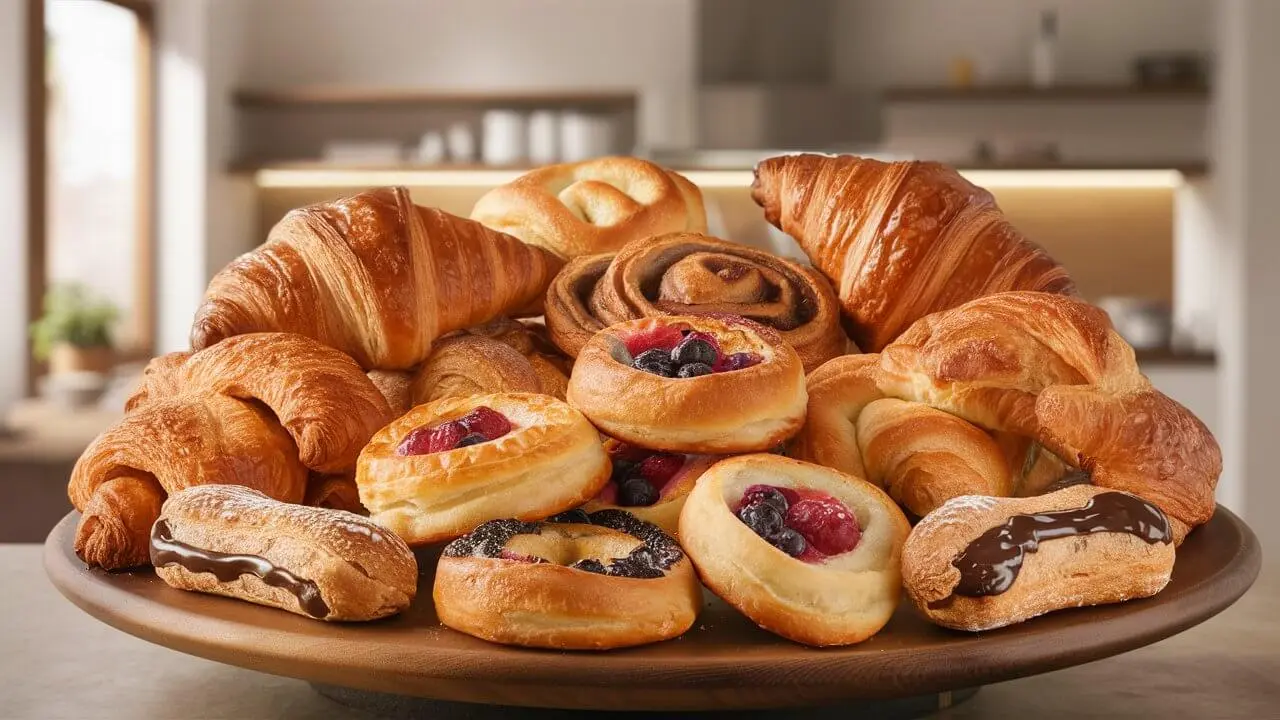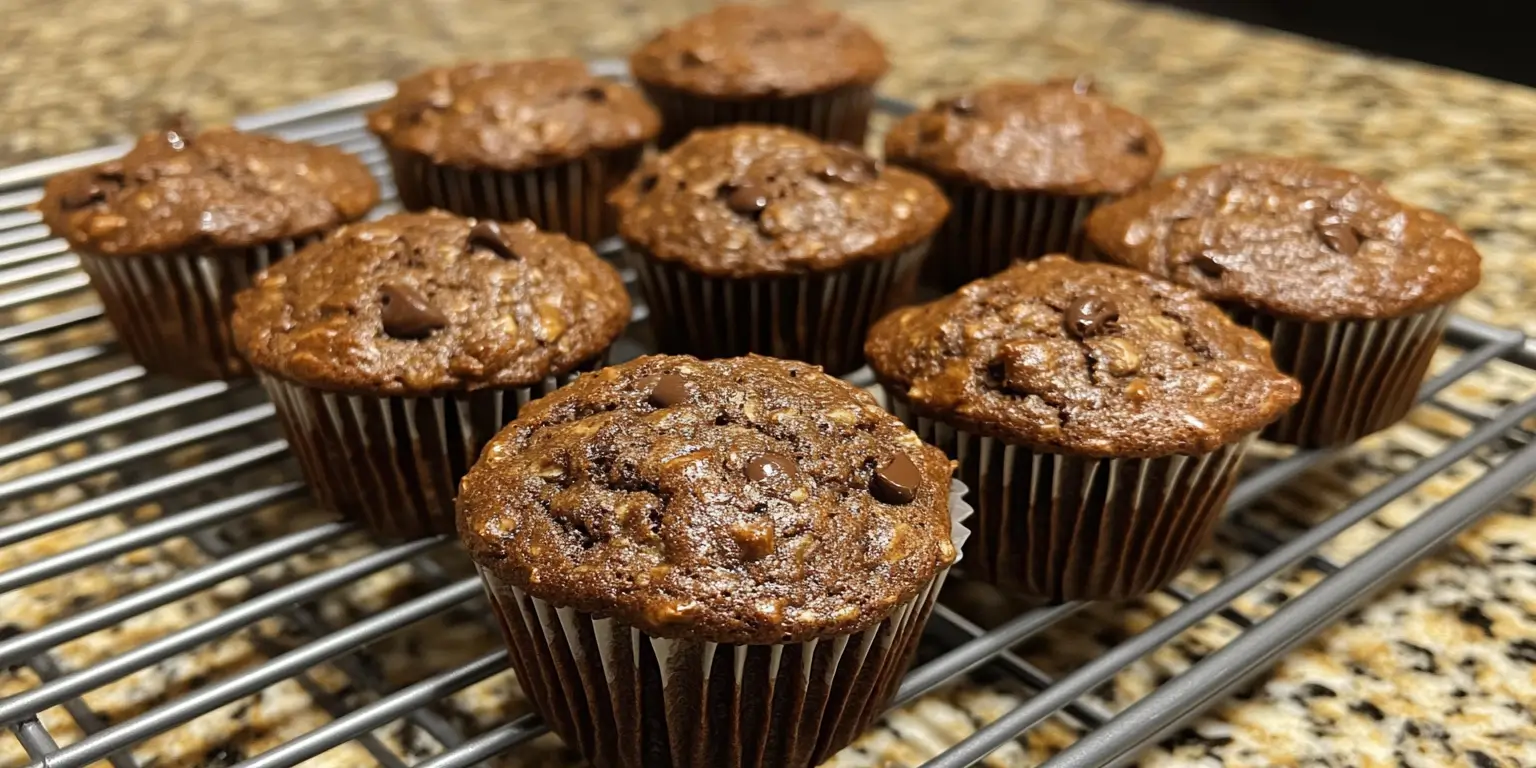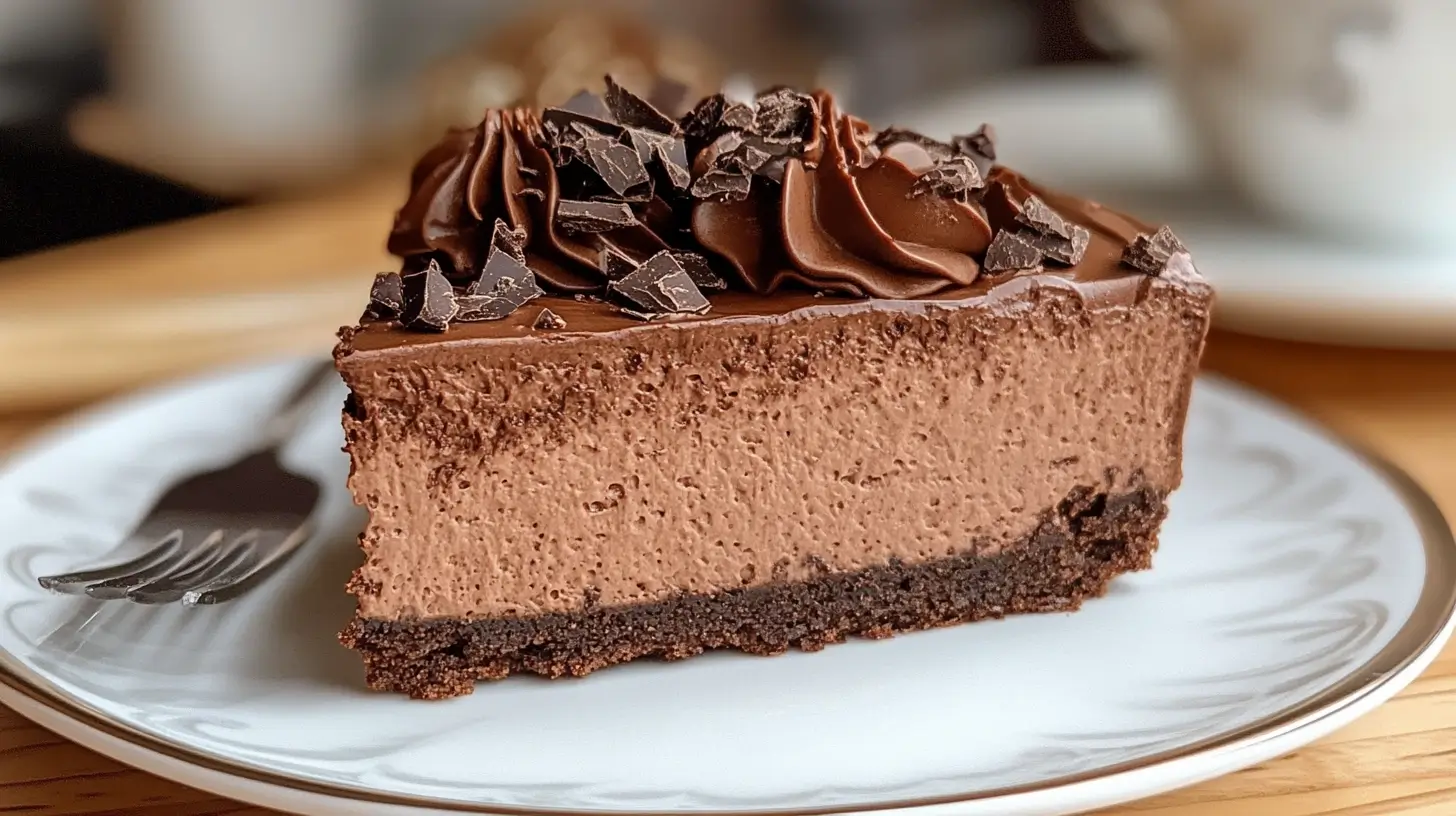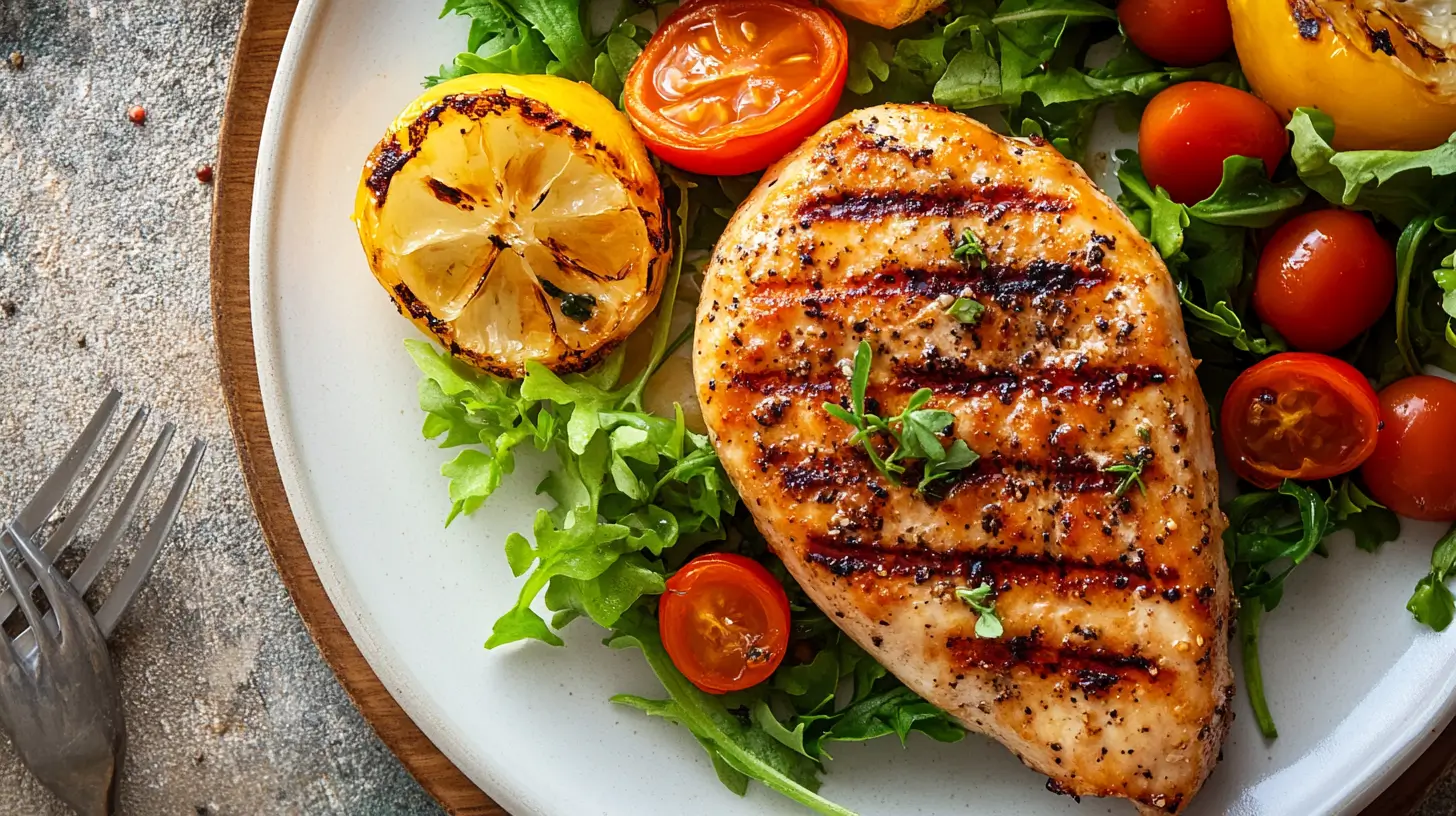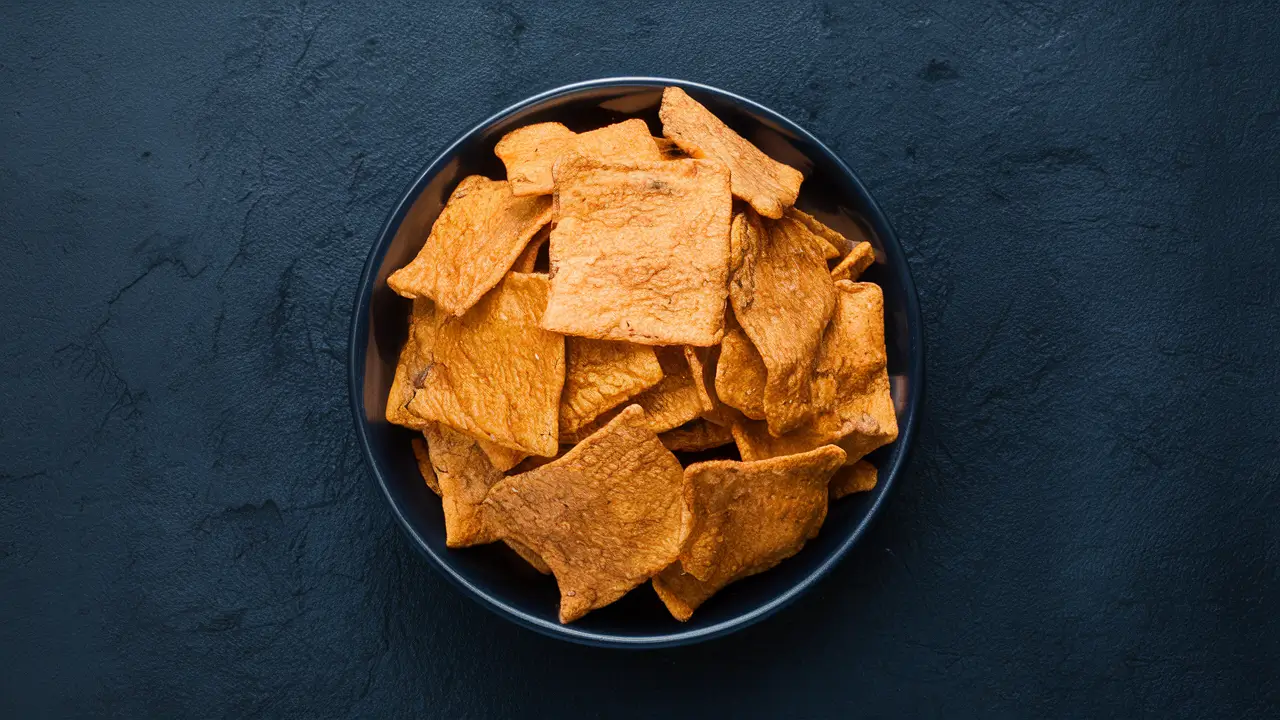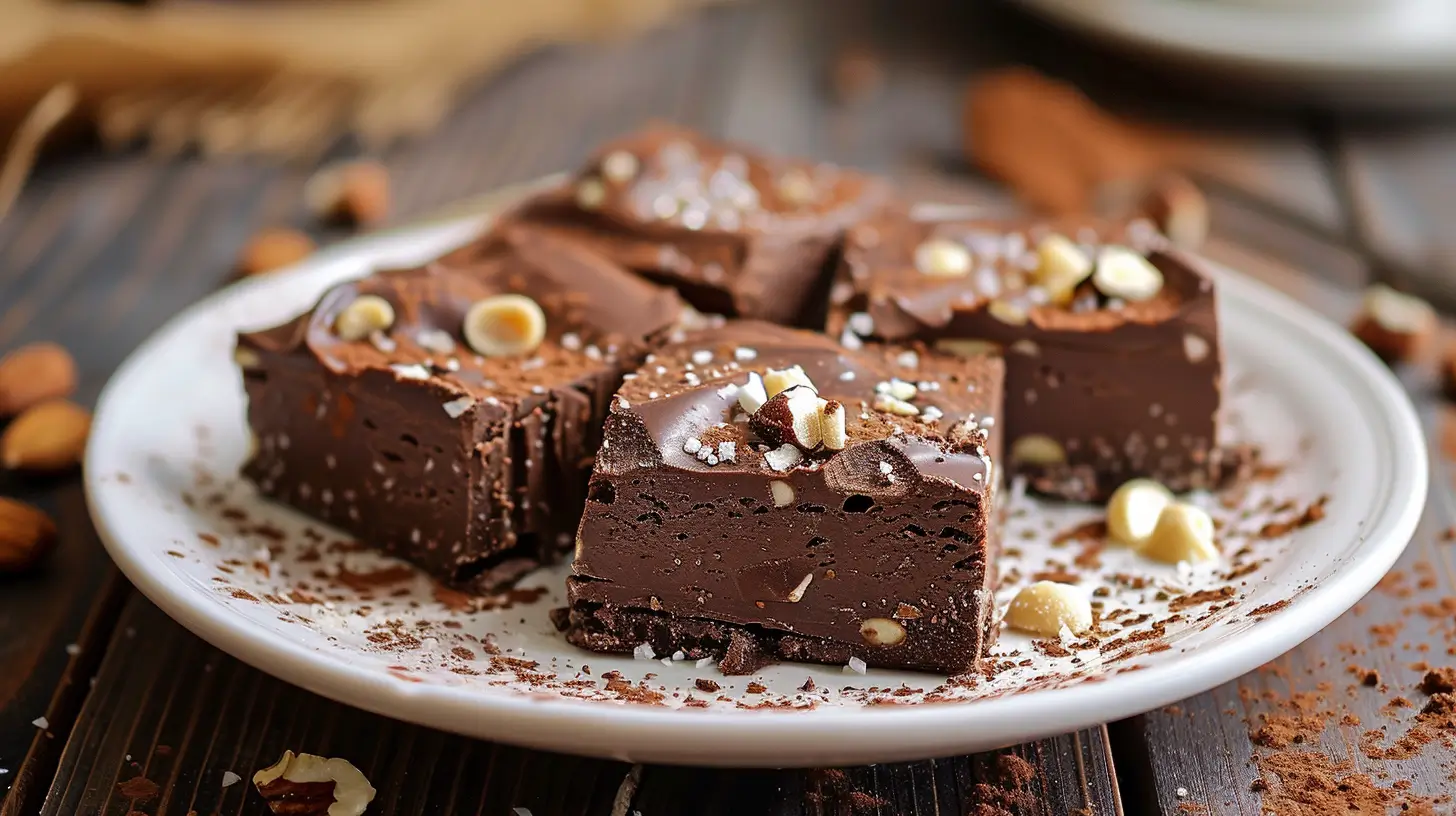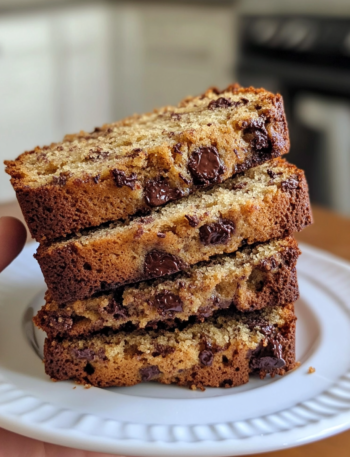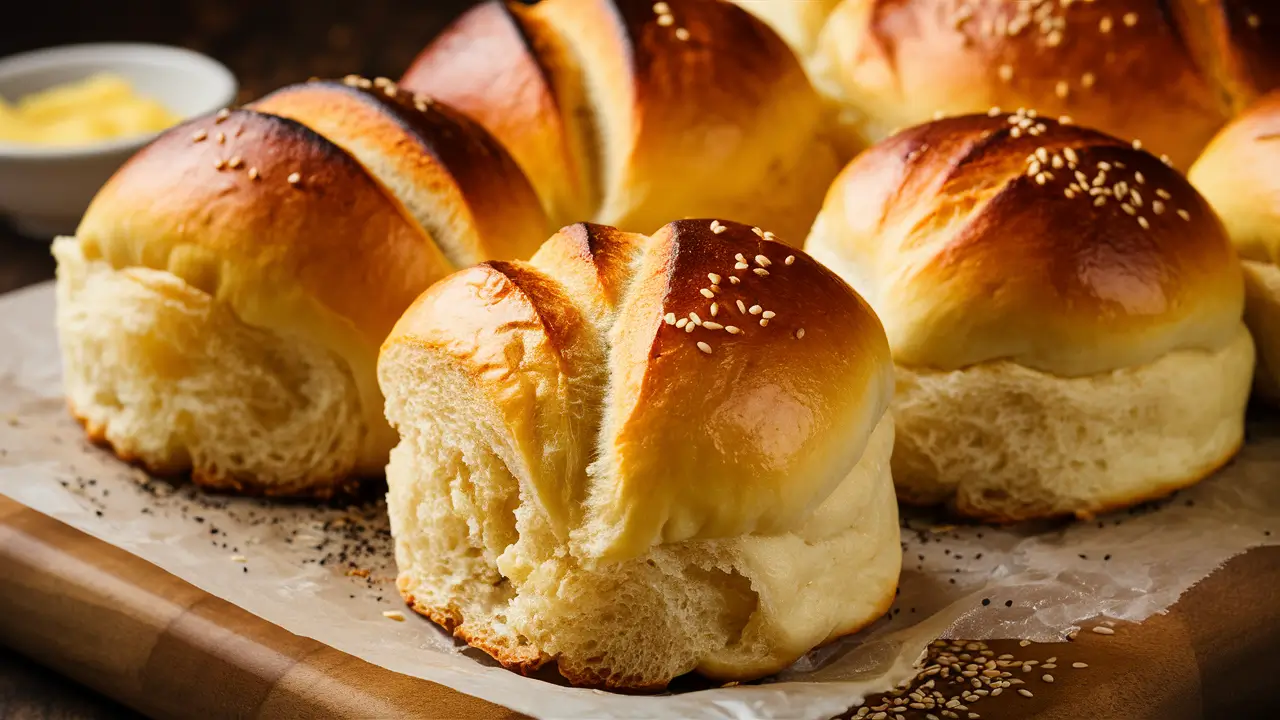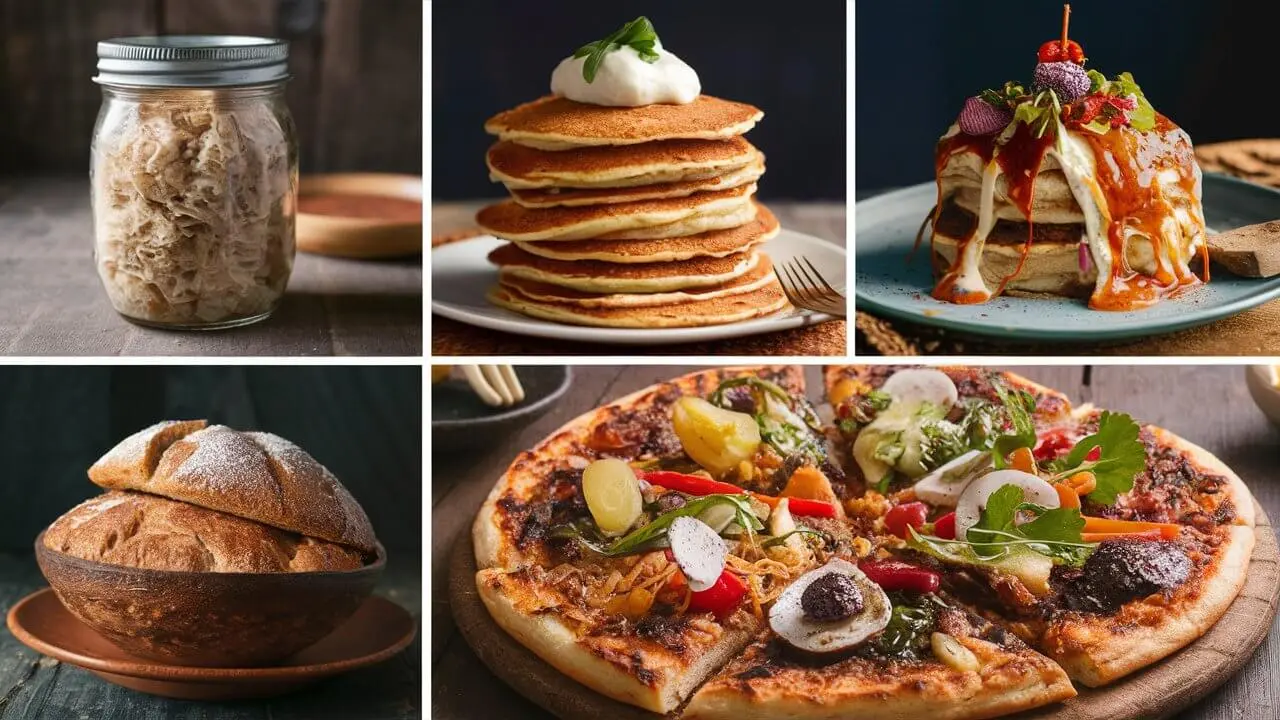Breakfast pastries are more than just a morning indulgence; they’re a beloved tradition that spans cultures and centuries. This article will explore the delightful world of breakfast pastries, from their rich history to their modern-day variations. We’ll dive into how these treats have evolved, the different types available, and tips for making them at home. Whether you’re a seasoned baker or just a pastry enthusiast, this guide has something for everyone. So, grab a cup of coffee, and let’s embark on this delicious journey.
Introduction to Breakfast Pastries
Breakfast Pastries – A Delicious Start to Your Day
Breakfast pastries have become a staple in many households and cafes around the world. They offer a quick, satisfying, and often decadent start to the day. But what exactly qualifies as a breakfast pastry? Typically, these are baked goods that are sweet or savory, enjoyed alongside a morning beverage like coffee or tea. From flaky croissants to warm muffins, there’s a wide variety to choose from, each with its unique texture and flavor.
The History of Breakfast Pastries
Understanding the origins of breakfast pastries gives us a deeper appreciation for these delightful treats. Pastries have been part of human cuisine for centuries, with early versions found in ancient Egyptian, Greek, and Roman cultures. These early pastries were often made with simple ingredients like honey and nuts, evolving over time to include more complex recipes and techniques.
Early Origins and Historical Significance
The earliest known pastries date back to ancient Egypt, where honey-sweetened cakes and bread were common. Greeks and Romans further developed pastry-making by introducing new ingredients and methods. For instance, the Romans are credited with creating the first puff pastry, a technique that involves layering dough and fat to create a light, airy texture.
Influence of Different Cultures
As pastry-making spread across Europe, it was influenced by various cultures, each adding its twist. The French perfected the art of puff pastry, leading to the creation of iconic breakfast items like croissants. In Denmark, the introduction of laminated dough gave rise to danishes. Each culture’s contribution has enriched the world of breakfast pastries, making it diverse and universally loved.
Types of Breakfast Pastries
What are the 4 Types of Pastry?
Pastry dough is a versatile component in the baking world, and understanding its types is crucial for both bakers and pastry lovers. There are four main types of pastry dough, each with unique characteristics and uses.
Shortcrust Pastry
Shortcrust pastry is known for its crumbly texture and rich flavor. It is often used for making tarts and pies. The dough is made by combining flour, fat (usually butter), and water. The key to perfect shortcrust pastry is to keep the ingredients cold and to handle the dough as little as possible to avoid developing gluten, which can make the pastry tough.
Puff Pastry
Puff pastry is famous for its light, flaky layers. It is made by repeatedly folding and rolling dough with butter, creating multiple layers that puff up during baking. This technique, known as lamination, results in a delicate, airy texture. Puff pastry is commonly used for croissants, turnovers, and vol-au-vents.
Choux Pastry
Choux pastry, or pâte à choux, is a light dough used to make pastries like éclairs, cream puffs, and profiteroles. The dough is unique because it is cooked on the stovetop before being baked. It consists of butter, water, flour, and eggs. When baked, it puffs up to create a hollow center, perfect for filling with cream or custard.
Filo Pastry
Filo pastry, also known as phyllo, is very thin and delicate. It is used in layered pastries like baklava and spanakopita. Filo dough is made by rolling out flour and water into paper-thin sheets. These sheets are brushed with butter or oil and layered to create a crisp, flaky texture when baked.
Examples of Popular Breakfast Pastries
Breakfast pastries come in various forms, flavors, and textures, making them a delightful way to start the day. Here are some popular examples from around the world:
Croissants
Croissants are perhaps the most famous breakfast pastry. Originating from France, these buttery, flaky pastries are made from laminated dough. They can be enjoyed plain or filled with ingredients like chocolate, almond paste, or ham and cheese.
Danishes
Danish pastries, or simply danishes, are sweet, multi-layered pastries made from laminated dough. They are typically filled with fruit preserves, custard, or cream cheese and often topped with icing or nuts. Danishes are a breakfast staple in many countries.
Muffins
Muffins are quick breads that can be sweet or savory. They are made from a batter that includes flour, sugar, eggs, and a leavening agent like baking powder. Muffins are easy to make and perfect for a grab-and-go breakfast.
Scones
Scones, originating from Britain, can be either sweet or savory. You make them from a dough similar to biscuits, using flour, butter, and milk or cream. You often find sweet scones containing fruits like raisins or currants, and they are traditionally served with clotted cream and jam.
Making Breakfast Pastries at Home
How to Make Breakfast Pastries at Home
Making breakfast pastries at home can be incredibly rewarding. You get to enjoy fresh, warm pastries straight from your oven, and you can customize them to your taste. Here are some basic techniques and tips to help you get started.
Basic Techniques and Tips
The key to great homemade pastries is mastering a few basic techniques:
- Keep Ingredients Cold: Especially for doughs like puff pastry and shortcrust, keeping the butter and dough cold helps create that perfect flaky texture.
- Don’t Overwork the Dough: Overworking can develop gluten, making the pastry tough. Handle the dough gently and minimally.
- Use Quality Ingredients: High-quality butter, fresh flour, and fresh fruits or nuts make a noticeable difference in the final product.
- Practice Patience: Allow dough to rest as needed, especially for puff and choux pastries.
Step-by-Step Process
Here’s a simplified process for making some popular breakfast pastries:
- Croissants:
- Prepare the Dough: Mix flour, sugar, salt, yeast, and milk to form a dough. Chill the dough.
- Lamination: Roll out the dough, place a slab of cold butter in the center, and fold it over. Roll out and fold the dough several times to create layers.
- Shaping: Cut the dough into triangles, roll them into croissant shapes, and let them rise.
- Baking: Brush with egg wash and bake until golden brown.
-
Muffins:
- Mix Dry Ingredients: Combine flour, sugar, baking powder, and salt.
- Mix Wet Ingredients: Beat together eggs, milk, and melted butter.
- Combine: Gently fold the wet ingredients within the dry ingredients. Then add fruits or chocolate chips if desired.
- Baking: Pour the batter into muffin tins and bake until a toothpick comes out clean.
- Scones:
- Prepare the Dough: Put flour, sugar, baking powder, and salt and mix the ingredients. Incorporate the cold butter into the mixture until it achieves a texture similar to coarse crumbs.
-
- Add Wet Ingredients: Stir in milk or cream and any add-ins like dried fruit.
- Shape and Bake: Pat the dough into a circle, cut into wedges, and bake until golden.
Ingredients Needed for Homemade Breakfast Pastries
Choosing the right ingredients is vital for making delicious breakfast pastries at home. Here are some essentials and tips on selecting them.
Essential Ingredients and Their Roles
- Flour: The base of most pastries. All-purpose flour is versatile, but some recipes may call for bread flour or pastry flour for different textures.
- Butter: Adds flavor and creates flakiness in pastries like croissants and puff pastry.
- Sugar: Sweetens the dough and helps with browning.
- Eggs: Provide structure and richness.
- Milk/Cream: Adds moisture and richness.
- Yeast/Baking Powder: Leavening agents that help the pastry rise.
- Salt: Enhances flavor.
Tips for Selecting Quality Ingredients
- Butter:
European-style butter has a higher fat content, which can improve the pastry’s texture
- Flour: Fresh, unbleached flour is best. keep it in a cool, dry place to keep the quality.
- Fruits and Nuts: Fresh, high-quality fruits and nuts will enhance the flavor and texture of your pastries.
Health Aspects of Breakfast Pastries
Nutritional Value of Breakfast Pastries
Breakfast pastries can be both indulgent and nutritious, depending on the ingredients and preparation methods. Understanding their nutritional value helps in making informed choices about how often and how much to enjoy.
Caloric Content and Nutritional Breakdown
The caloric content of breakfast pastries varies widely:
- Croissants: Approximately 250-300 calories each, mainly from fat and carbohydrates.
- Muffins: Between 200-500 calories, depending on size and ingredients.
- Scones: Around 200-400 calories, often higher in fat due to cream and butter.
In addition to calories, consider these nutritional aspects:
- Fats: Butter and cream contribute to the fat content, offering richness but also increasing calorie count.
- Carbohydrates: Flour and sugar provide the bulk of the carbs, giving energy but sometimes leading to sugar spikes.
- Proteins: Eggs and dairy add protein, which can help keep you full longer.
- Fiber: Whole grain flours and added fruits or nuts increase fiber content, aiding digestion.
Vitamins and Minerals
Certain ingredients can boost the nutritional profile of breakfast pastries:
- Whole Grains: Provide B vitamins, iron, and magnesium.
- Fruits: Add vitamins A and C, fiber, and antioxidants.
- Nuts: Offer healthy fats, protein, and essential minerals like magnesium and potassium.
Are Pastries for Breakfast Healthy?
While breakfast pastries can be delicious, their healthiness depends on how they are made and consumed.
Pros and Cons of Eating Pastries for Breakfast
Pros:
- Convenience: Quick and easy to grab on busy mornings.
- Variety: A wide range of flavors and textures to suit different tastes.
- Satiety: Can be filling, especially those with protein and fiber.
Cons:
- High in Calories: Many pastries are calorie-dense, which can lead to weight gain if consumed excessively.
- High in Sugar: Can cause energy spikes and crashes.
- Low in Nutrients: Some pastries, especially those made with refined flours and sugars, lack essential nutrients.
Healthier Alternatives and Modifications
You can make breakfast pastries healthier with a few simple adjustments:
Use Whole Grain Flour: Boosts fiber content and adds essential nutrients.
Reduce Sugar: Choose natural sweeteners such as honey or maple syrup.
Add Fruits and Nuts: Boosts nutritional value and adds natural sweetness.
Control Portions: Enjoy smaller servings to keep calorie intake in check.
Cultural Significance and Traditions
Why Do People Eat Pastries for Breakfast?
Breakfast pastries have a universal appeal and are enjoyed for various reasons.
Cultural and Traditional Reasons
In many cultures, breakfast pastries are a traditional part of the morning meal:
- France: Croissants and pain au chocolat are staple items in French breakfasts.
- Denmark: Danishes, known locally as “wienerbrød,” are popular.
- Mexico: Pan dulce, including conchas and churros, are commonly enjoyed with coffee.
Convenience and Variety
Pastries offer convenience, especially for those with busy mornings.
The variety available—from sweet to savory—ensures there’s something for everyone.
Breakfast Pastries Around the World
Pastries are a global phenomenon, with each region offering its unique take on these delightful treats. Here are some examples of how different cultures enjoy breakfast pastries.
French Pastries
French breakfast pastries are renowned for their delicate textures and rich flavors. Croissants and pain au chocolat are only the start. Other popular choices include:
- Pain aux Raisins: A spiral pastry filled with custard and raisins.
- Brioche: A sweet, buttery bread that is soft and fluffy.
Scandinavian Pastries
Scandinavia, particularly Denmark, has a rich tradition of pastry-making. In addition to danishes, there are:
- Kanelbullar (Sweden): Cinnamon buns that are less sweet than their American counterparts but equally delicious.
- Pulla (Finland): Sweet cardamom-flavored bread, often braided and sprinkled with sugar.
Asian Pastries
In many Asian countries, breakfast pastries incorporate unique local flavors:
- Chinese Egg Tarts: Small tarts with a flaky crust and a creamy egg custard filling, often enjoyed with tea.
- Japanese Melon Pan: A sweet bun covered with a thin layer of cookie dough, giving it a crunchy exterior.
Popular Breakfast Pastries
Detailed Descriptions of Popular Pastries
- Croissants: Buttery, flaky, and often enjoyed plain or filled with chocolate or almond paste. Their delicate layers make them a favorite worldwide.
- Danishes: Sweet pastries with various fillings like fruit preserves, custard, or cream cheese. Known for their rich flavor and flaky texture.
- Muffins: Quick breads that come in countless flavors, including blueberry, chocolate chip, and bran. Muffins are versatile and easy to make.
- Scones: British-origin pastries that can be sweet or savory. You can try them with clotted cream and jam, especially during afternoon tea.
Specialty Breakfast Pastries
- Pain d’Amande (France): Almond bread that is sweet and often studded with sliced almonds.
- Ensaimada (Spain): A sweet, spiral-shaped pastry from Mallorca, traditionally made with lard and topped with powdered sugar.
- Quesito (Puerto Rico): A pastry filled with sweetened cream cheese and often glazed with syrup.
Tips for Enjoying Breakfast Pastries
Best Ways to Enjoy Breakfast Pastries
Breakfast pastries are a treat, and there are ways to elevate the experience even more. Whether you’re enjoying them at home or on the go, a few tips can make your pastry indulgence even more delightful.
Pairings and Serving Suggestions
- With Coffee or Tea: Pastries and a hot beverage are a match made in heaven. The bitterness of coffee or the soothing quality of tea balances the sweetness of pastries perfectly. Try pairing a buttery croissant with a strong espresso or a sweet danish with a cup of chamomile tea.
- Add Fresh Fruit: Fresh fruit adds a refreshing contrast to the richness of pastries. A bowl of berries or sliced fruit complements the flavors and provides a healthier touch.
- Warm Them Up: Many pastries taste even better when slightly warmed. Heat them in the oven or microwave for a few seconds to enhance their aroma and texture.
- With Yogurt or Cream: Serving pastries with a side of yogurt or whipped cream can add a creamy element that pairs well with the flaky texture of the pastry.
Special Occasions
Breakfast pastries are not just for everyday enjoyment; they can also be a highlight of special occasions:
- Brunch Gatherings: Include a variety of pastries in your brunch spread to impress guests. Offer a mix of sweet and savory options to cater to different tastes.
- Holiday Breakfasts: Serve special pastries like stollen or panettone during holiday breakfasts for a festive touch.
- Celebrations: Use pastries as a celebratory treat for birthdays or anniversaries. A beautifully arranged platter of assorted pastries can be a delightful centerpiece.
Storing and Reheating Pastries
Proper storage and reheating are key to maintaining the quality of your breakfast pastries. Here are some tips to keep them fresh and delicious.
Storing Pastries
- Airtight Containers: Store pastries in airtight containers to keep them from drying out. This is especially important for items like muffins and scones.
- Cool, Dry Place: Keep pastries in a cool, dry place away from direct sunlight. Room temperature is usually ideal, but for longer storage, consider refrigerating or freezing them.
- Layering: If storing multiple pastries, place a piece of parchment paper between layers to prevent them from sticking together.
Reheating Pastries
- Oven Method: Preheat your oven to 350°F (175°C). Place the pastries on a baking sheet and warm them for about 10 minutes max. This method helps restore their flakiness and prevents them from becoming soggy.
- Microwave Method: Place the pastry on a microwave-safe plate and heat for 10-20 seconds. Be careful not to overheat, as this can make the pastry tough.
- Toaster Oven: A toaster oven is a great option for reheating small pastries like croissants or danishes. It provides even heating and helps maintain their crisp texture.
Conclusion
Wrapping Up Our Journey Through Breakfast Pastries
Breakfast pastries are more than just a delicious way to start your day—they’re a celebration of culinary tradition and craftsmanship. From their rich history to the variety of flavors and textures they offer, these treats hold a special place in our hearts and kitchens. Whether you enjoy them fresh from a bakery or homemade, there’s no denying the joy they bring.
We’ve explored the origins of breakfast pastries, delved into the different types, and provided tips for making and enjoying them. We’ve also looked at the health aspects and cultural significance, offering a comprehensive guide to these beloved morning delights.
Key Takeaways
- Variety and Tradition: Breakfast pastries come in a vast array of types, each with its own history and cultural significance.
- Homemade Delights: Making pastries at home can be a rewarding experience, allowing for customization and fresher results.
- Health Considerations: While indulgent, pastries can be part of a balanced diet when enjoyed in moderation and with healthier ingredient choices.
- Enjoyment Tips: Pairing pastries with beverages, adding fresh fruit, and proper storage can enhance your pastry experience.
Frequently Asked Questions
Are pastries for breakfast?
Yes, pastries are a popular choice for breakfast due to their convenience, variety, and delicious taste. They can be enjoyed as a quick morning treat or a part of a more leisurely breakfast.
What are the 4 types of pastry?
The four main types of pastry are shortcrust, puff, choux, and filo. Each type has unique characteristics and uses, from tarts and pies to croissants and éclairs.
What are examples of pastries?
Popular examples of pastries include croissants, danishes, muffins, scones, éclairs, and baklava. These pastries vary widely in flavor, texture, and ingredients.
Why do people eat pastries for breakfast?
People enjoy pastries for breakfast due to their convenience, wide range of flavors, and cultural traditions. They offer a quick, satisfying start to the day.
Are breakfast pastries bad for you?
While breakfast pastries can be high in sugar and fat, enjoying them in moderation and opting for healthier versions can make them a part of a balanced diet.

